Visualization of Gastric Acid Reflux Using Mobile-Based Augmented Reality
Abstract
Interactive information media has many benefits in the process of conveying information, one of which is by visualizing objects in real time. Socialization activities at the Rensing Health Center in conveying information on gastric diseases still do not use visual aids as a medium for delivering counseling. Therefore, this study aims to develop information media in the form of an android application by utilizing Augmented reality (AR) technology to show the stomach acid process in real time which is visualized in the form of 3D animation. The method used in application development is Multimedia Development Life Cycle (MDLC). Where this method consists of 6 (six) stages of development, namely concept, design, Material Collecting, Assembly, testing and distribution. The results of this study are a visualization application of gastric acid reflux using mobile-based augmented reality built using Unity 2017.3.1f1 and the Vuforia Software Development Kit (SDK), with several stages of the process, namely entering the database and all assets into unity, lighting, creating a user interface, scripting and finally build the application to the android platform Based on the results of application trials that have been carried out at the Rensing Health Center, it shows that mobile-based augmented reality has succeeded in assisting officers in visualizing gastric acid reflux. The satisfaction of health officers in using the application can be seen from the results of the questionnaire to the respondents, where the results of the questionnaire 32% stated strongly agree, 59% agreed, 6% disagreed and 2% disagreed.
References
[2] D. I. Soybel, “Anatomy and Physiology of the Stomach,” vol. 85, p. 6109, 2005, doi: 10.1016/j.suc.2005.05.009.
[3] A. Saputra and J. Sukmana, “Sistem pakar untuk mendiagnosis penyakit lambung dan penanganannya menggunakan metode dempster shafer,” vol. VI, 2019.
[4] R. Ardiansyah, F. Fauziah, and A. Ningsih, “LAMBUNG MENGGUNAKAN METODE DEMPSTER-SHAFER,” vol. 24, no. 3, pp. 182–196, 2018.
[5] D. Nincarean, M. Bilal, N. Dayana, A. Halim, and H. Abdul, “Mobile Augmented Reality : the potential for education,” vol. 00, 2013.
[6] A. Satriadi, A. Adil, and T. Informatika, “MOBILE ANDROID,” pp. 335–344.
[7] R. Budiawan, T. N. Damayanti, and D. A. Nurmantris, “Pembelajaran Elektromagnetika Terapan Berbasis Augmented Reality : Kasus Sistem Koordinat,” vol. 6, no. 4, pp. 436–444, 2017.
[8] W. Li, A. Y. C. Nee, and S. K. Ong, “A State-of-the-Art Review of Augmented Reality in Engineering Analysis and Simulation,” 2017, doi: 10.3390/mti1030017.
[9] I. Express, L. Volume, I. International, C. S. Faculty, I. Marzuki, and W. N. Tenggara, “AN INTERACTIVE MOBILE AUGMENTED REALITY SYSTEM,” vol. 15, no. 12, pp. 1337–1343, 2021, doi: 10.24507/icicel.15.12.1337.
[10] W. Li, A. Y. C. Nee, and S. K. Ong, “A state-of-the-art review of augmented reality in engineering analysis and simulation,” Multimodal Technol. Interact., vol. 1, no. 3, 2017, doi: 10.3390/mti1030017.
[11] Suci Aulia, Raymond Y. Purba, and Agus Gunarso, “Media Informasi untuk Bank Baterai Berbasis Augmented Reality,” J. Nas. Tek. Elektro dan Teknol. Inf., vol. 9, no. 3, pp. 254–260, 2020, doi: 10.22146/.v9i3.381.
[12] L. Kamelia, “PERKEMBANGAN TEKNOLOGI AUGMENTED REALITY SEBAGAI MEDIA PEMBELAJARAN INTERAKTIF PADA MATA,” vol. IX, no. 1, 2015.
[13] C. O. Karundeng, D. J. Mamahit, B. A. Sugiarso, T. Informatika, U. Sam, and R. Manado, “Rancang Bangun Aplikasi Pengenalan Satwa Langka di Indonesia Menggunakan Augmented Reality,” vol. 14, no. 1, pp. 1–8, 2018.
[14] S. Ćuković, M. Gattullo, F. Pankratz, G. Devedžić, E. Carrabba, and K. Baizid, “Marker based vs. natural feature tracking augmented reality visualization of the 3D foot phantom,” no. June, 2015.
[15] C. Juan, F. Beatrice, and J. Cano, “An Augmented Reality System for Learning the Interior of the Human Body”.
[16] A. K. Wahyudi, “ARca , Pengembangan Buku Interaktif Berbasis Augmented Reality dengan Smartphone Android,” vol. 3, no. 2, pp. 96–102.
[17] H. Pratikno, “Kontrol Gerakan Objek 3D Augmented Reality Berbasis Titik Fitur Wajah dengan POSIT,” vol. 4, no. 1, pp. 16–24.
[18] A. Adil, R. A. Dwiputri, and B. K. Triwijoyo, “Aplikasi Spasial Rekomendasi Wisata Terdekat dengan Metode Haversine Berbasis Mobile The Nearest Tourism Recommendation Application with The Mobile-Based Haversine Method,” vol. 4, no. 1, pp. 95–106, 2022, doi: 10.30812/bite.v4i1.1948.
[19] H. Sugiarto, “Penerapan Multimedia Development Life Cycle Pada Aplikasi Pengenalan Abjad Dan Angka,” vol. 3, no. 1, pp. 26–31, 2018.












